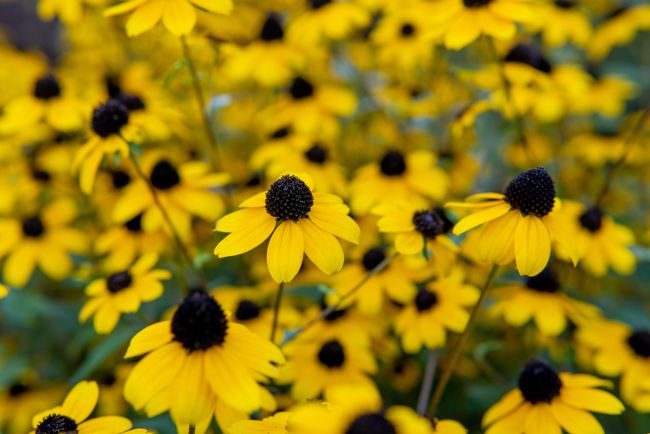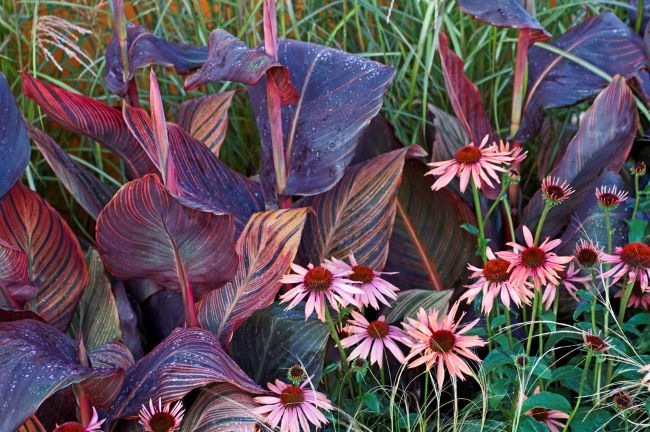Flowering Plants for July/August


Two very dependable plants that flower in late July and August are Echinacea and Rudbeckia
Echinacea purpurea, commonly known as purple coneflower, is a striking summer-to-fall bloomer, with its peak flowering typically in August in many regions. Its blooms are usually a vibrant purple, though some cultivars may display white or pink flowers. Native to the central and eastern United States, Echinacea purpurea is cherished both as an ornamental garden plant and for its reputed immune-boosting medicinal benefits.
Rudbeckia ‘Goldsturm,’ or Black-Eyed Susan, is another popular summer-to-fall flowering plant, also reaching its peak in August. Native to the same regions, this plant is widely grown for its bright yellow flowers with distinctive dark brown or black centres. It is highly attractive to bees, butterflies, and other pollinators, making it a favourite for gardeners and floral arrangements.
For a contemporary wildflower aesthetic in the autumn garden, consider pairing Echinacea and Rudbeckia with ornamental grasses for a dynamic and natural look.

Here are a few more flowering plants that bloom in August in the UK:
Asters: These colourful, daisy-like perennials are a favourite for late-season colour, coming in a variety of vibrant shades such as pink, purple, blue, and white. Their star-shaped blooms attract bees and butterflies, making them an excellent addition to pollinator-friendly gardens. Asters are easy to grow and thrive in full sun, with blooming periods stretching from late summer through autumn, offering an extended display of beauty when other flowers have faded.
Dahlias: Known for their dramatic, showy blooms, Dahlias are a versatile addition to any garden, offering a range of colours from soft pastels to bold, saturated hues like red, yellow, and deep purple. These flowers come in an array of forms, from small, delicate single flowers to massive, intricate blooms, often reaching up to 30 cm across. Dahlias can be used in beds, borders, or containers and are especially popular in cut flower arrangements. With proper care, they can bloom continuously from midsummer until the first frost.
Marigolds: These cheerful, hardy annuals are a staple in summer gardens, with their bright yellow, orange, or deep red blooms bringing warmth and vibrancy. Marigolds are known for their pest-repellent properties, as their strong scent can help deter garden insects, making them an ideal companion plant. Their blooms last throughout the summer and into the autumn, providing a long-lasting, low-maintenance splash of colour. Marigolds thrive in full sun and are particularly suited to borders, containers, or as part of vegetable gardens.
Sunflowers: Tall, majestic, and iconic, Sunflowers can grow to impressive heights, with their large, golden-yellow blooms standing out against their sturdy, green stems. Their flower heads follow the sun during the day, a phenomenon known as heliotropism. Sunflowers not only provide visual impact but are also valuable for wildlife, offering seeds for birds and nectar for pollinators. Their varieties range from smaller, compact types suitable for pots to towering giants, which can grow over 3 metres tall.
Zinnias: A garden favourite, Zinnias are known for their vibrant, long-lasting blooms that come in an array of colours, including pink, red, purple, orange, and yellow. These sun-loving annuals are incredibly easy to grow and produce flowers continuously from midsummer to autumn. Zinnias attract butterflies and other pollinators, making them an excellent choice for wildlife-friendly gardens. Their bright, cheerful flowers can be single, semi-double, or double, adding variety to beds, borders, or container plantings.
Lavender (Lavandula angustifolia): Famous for its calming scent and medicinal properties, Lavender is a beloved addition to any garden. This aromatic shrub produces spikes of delicate purple flowers in the summer, typically blooming in July and August. It thrives in well-drained soil and full sun, making it perfect for rock gardens or Mediterranean-style landscapes. Lavender is frequently used in perfumes, essential oils, and even culinary dishes. In the garden, it also attracts bees and other pollinators while adding a sense of tranquillity.
Crocosmia (Crocosmia spp.): Also known as Montbretia, Crocosmia is a striking plant that produces tall, arching stems adorned with vibrant orange or red trumpet-shaped flowers. These eye-catching blooms appear from July through August, adding a bold splash of colour to borders and flowerbeds. The plant’s sword-like leaves add texture and height to garden displays, and it is commonly used in cut flower arrangements. Crocosmia is a hardy perennial that prefers sunny spots and well-drained soil, thriving in cottage gardens or wildflower meadows.
Helenium (Helenium spp.): With its daisy-like flowers in warm shades of red, orange, and yellow, Helenium is perfect for adding rich, autumnal tones to your garden from mid-summer through early autumn. These perennials grow in clumps, producing masses of vibrant blooms that are particularly attractive to pollinators like bees and butterflies. Helenium is well-suited to cottage gardens, naturalistic planting schemes, and wildflower meadows. It prefers full sun and is known for its resilience and long-lasting display.
Phlox (Phlox spp.): Known for its sweetly scented blooms, Phlox is a staple in cottage gardens. Its dense clusters of flowers, which come in shades of pink, purple, and white, appear from mid-summer through early autumn. Phlox thrives in full sun to partial shade and prefers moist, well-drained soil. The plant works well in borders, mass plantings, or as ground cover. Its strong fragrance and nectar-rich flowers attract a wide range of pollinators, making it a favourite among gardeners who wish to support local wildlife.
Agapanthus (Agapanthus spp.): Often referred to as “Lily of the Nile,” Agapanthus produces large, showy clusters of blue, purple, or white flowers atop tall, slender stems. Blooming from July to August, these exotic-looking plants add a touch of elegance to borders, patios, and container gardens. Agapanthus is particularly suited to Mediterranean-style gardens, where its bold flowers stand out against sun-soaked landscapes. It thrives in full sun and well-drained soil, offering an architectural quality to planting schemes.
Penstemon: Known for its tubular flowers that come in a variety of vibrant colours including red, pink, purple, and white, Penstemon is a hardy perennial that brings long-lasting beauty to the summer garden. Blooming from early summer until autumn, this plant attracts hummingbirds, bees, and butterflies. Its tall spikes of flowers add vertical interest to beds and borders, and its foliage remains attractive even after flowering. Penstemon is drought-tolerant and thrives in well-drained soil, making it an excellent choice for dry, sunny gardens or borders.Other flowering plants that may be in bloom in August in the UK include foxgloves, with their tall spires of tubular flowers; hollyhocks, known for their towering presence and wide range of colours; petunias, which bring a cascade of colourful blooms in hanging baskets; and snapdragons, with their dragon-like flowers in a multitude of hues. Each of these plants contributes to the vibrant summer garden with its unique form and colour palette.





















